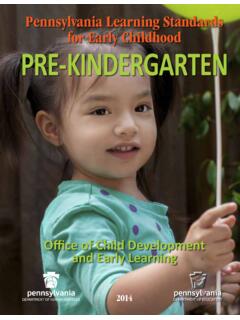Transcription of Introduction to Mosston’s Spectrum of Teaching Styles
1 1 Introduction to Mosston s Spectrum of Teaching Styles A Brief Review of Literature about the Spectrum of Teaching Styles * Written by Howard Zhenhao Zeng ( E.) Department of Physical Education and Exercise Science Brooklyn College of the City University of New York * Published in: Zeng, Z. H., & Gao, Q. (2012). Teaching Physical Education Using the Spectrum of Teaching Style: Introduction to Mosston s Spectrum of Teaching Style. China School Physical Education; , pp. 65-68. Mosston s Spectrum of Teaching Styles provided comprehensive and coherent ideas link theories about Teaching and learning that are useful for teachers to implement in their gymnasiums (Ashworth, 2008a Cothran et al 2005; Metzler, 2000).
2 Theories about Teaching directly influence teacher s perceptions, beliefs, and behaviors in their understanding and implementation of Teaching . Throughout the years, there have been numerous advances to the ways of Teaching in school physical education and in the physical education teacher education (PETE) major program. One original and significant development emerged forty-five years ago by a man named Muska Mosston; he formulated The Spectrum of Teaching Styles (STS), which educators all over the world currently implement into their teacher training programs and classroom lessons on a daily basis (Ashworth, 1995). Mosston s STS designates eleven landmark Teaching Styles each style can be recognized by a specific name or a corresponding letter.
3 The appeal of this framework is that it offers different Teaching and learning approaches that assist in the development of a variety of educational goals and they help teachers meet the needs and interests of each student. In addition, this framework offers an instructor the opportunity to see how to constantly modify his or her curriculum to meet different educational goals. Since students do not have the same motivations and do not learn the same, the Spectrum allows the instructor to differentiate instruction (Ashworth, 2008b). Mosston s Spectrum may be used as a guiding principle and an opportunity for constant growth as a physical educator (Ashworth, 1992).
4 Since the STS were introduced to the field of Teaching physical education (Byra, 2002; Mosston & Ashworth, 1994, 2002, 2008b), it has been recognized by educators in many countries around the world and widely applied in their PETE programs. 2 Conceptually, the STS have continuously been refined since the first edition in 1966. (Boschee, 1972; Byra & Marks, 1993; Ernst & Byra, 1998; McCullick & Byra, 2002; Mosston & Ashworth, 1994, 2002, 2008b). Validating selected theoretical frameworks associated with the STS continues to be critical in the search for knowledge in regard to various instructional Styles (Hurwitz, 1985; Metzler, 1983; Mariani, 1970; McCullick & Byra, 2002; Mosston & Ashworth, 1994, 2008; Seifried, 2005).
5 As Ashworth (2008) indicated, The Spectrum is a unified theory about Teaching and learning behavior; and a comprehensive framework for understanding the Teaching - learning process. (Ashworth, 2008b). After Mosston s unfortunate passed away in 1994, his long-time colleague Dr. Sara Ashworth, a distinguish professor, researcher and leader in the field of Teaching physical education (She is the copyright holder of the First Online Edition of Teaching Physical Education, 2008), continued the quest to further delineate the Spectrum theory. Moreover, from 1980 to 2010, Dr. Ashworth has continued to present and conduct workshops throughout the USA, Canada, Europe, the Middle East, South America and Taiwan.
6 As researchers have pointed out, there is no single, perfect style of Teaching that could be utilized within the framework of Teaching physical education. Verifying the effect of the STS is always an interesting topic in the research of pedagogical inquiry (Byra & Jenkins, 2000; Gerney & Dort, 1992; McCullick & Byra, 2002; Mosston & Ashworth, 2008; Zeng et al., 2009). As a result, teachers and scholars in the field of Teaching physical education apply the STS as a framework for delivering instruction and conducting research at different school levels (Byra & Jenkins, 2000; Gerney & Dort, 1992; Greenspan, 1992; Mellor, 1992; Metzler, 2000; Zeng et al.)
7 , 2009). The findings of those pedagogical studies provided valuable information that enabled teachers to purposefully prepare and implement their Teaching to match with various Teaching objectives and the characteristics of their diverse learners (Byra & Jenkins, 2000; Greenspan, 1992; Metzler, 2000; Seifried, 2005; Zeng et al., 2009). Mosston s STS is based on the notion that Teaching is a chain of decision-making events for both the teachers and students. Mosston s identification of the specific decisions and the clustering of these decisions produced the Spectrum , that is various 3 landmark Teaching - learning Styles , each embracing different learning objectives significantly.
8 The Spectrum allows for the learner to develop in unique ways by creating diverse experiences through each landmark style. Every Teaching episode provides the learner an opportunity to focus on different attributes along each of the five developmental channels: cognitive, social , emotional , physical, and moral/ethical. (Ashworth, 2008b). Physical education is a unique subject that allows for growth of the whole individual. The Spectrum s non-versus approach (meaning: no one Teaching - learning approach is better than another) allows the student to be an integral part of his/her learning outcomes. In Mosston s Spectrum , each episode has a pedagogical unit that consists of a flow of objectives, Teaching behavior, learning behavior, and outcomes The O-T-L-O) (Mosston & Ashworth, 2008).
9 As the O-T-L-O diagram shows below: Teaching objectives and outcomes have both subject matter and behavioral components. The subject matter consists of the task being performed ( learning tennis serving, basketball shooting, volleyball bumping, soccer dribbling; and learning offensive and defensive plays, etc.). The behavioral component consists of the human behavior actions of the learner ( , How do we want the learners to participate or interact while performing 4 the task? Cooperating with fellow students, self-assessment which relies on cognitive skills and honesty in evaluation of oneself or others, self-control, etc.)
10 It is through these subject matters and behavior outcomes that a student develops cognitive, social , emotional , physical, and moral/ethical attributes (Ashworth, 2008b). The central axiom of the Spectrum theory is that Teaching behavior is a chain of decision making (Mosston & Ashworth, 2008). This axiom might produce the question: what is the best way to teach? The Spectrum of Teaching gives teachers various options on how to teach based on the decision making behaviors of the teacher and student. The increasing awareness of the constructionist nature of learning suggests that the teacher centered (versus) style of learning may be ineffective in maximizing student learning (Cothran and Kulinna, 2003).




